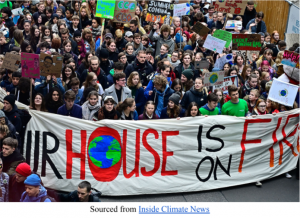Kids: To Have or Not To Have?
By Emma Andersson

Photo by Chayene Rafaela on Unsplash
Five years ago, my family invested in a hybrid car. Three years ago, I adopted a vegetarian diet. I recently started to compost. What these changes share is the intent to reduce my carbon footprint in response to environmental climate trends.
Despite these actions, global temperatures continue to rise, on track to hit four degrees Celsius of warming by the century’s end. Food staple yields show a decline for the past 30 years and are expected to follow that pattern. The population will increase by billions, boosting emissions. Consequently, ecosystems undergo damage and species face extinction, heat waves and droughts occur more frequently, and people worldwide experience worsening health due to limited food and water access.
In light of such forecasts, I wonder what else I can do.
One study proposes an answer, though it is shocking: have less children. It shows that a combination of conservation methods, including driving less and using energy-efficient appliances, saves 488 metric tons of CO2 over a lifetime; having one fewer child saves 9,441. Though I have considered opting out of procreation, its environmental impact has never been at the forefront of my mind. However, maybe it should: choosing not to reproduce, in terms of impact, would outweigh the ten next most-discussed mitigants, including recycling and vegetarianism. More people means more waste generation; energy, food, and mineral consumption; and ecosystem alteration. And having one less child not only eliminates its emissions, but prevents all emissions its subsequent descendants would contribute.
Bram, a 19-year old male, worries less about individual carbon emissions than he does about the environmental hazards his children might face: “I could see myself having a family, but I’m scared that my kids will live to see a post-apocalyptic world. What will it be like for them, when we run out of oil and other resources?” Children, whose immune systems are weaker and more sensitive to disease and pollution, already face environmental hazards, with conditions only worsening. In 2012, WHO estimated that 1.7 millions deaths in children under five were attributable to the environment. In 2050, an additional 24 million children are projected to be malnourished due to the climate crisis. And what more will children endure, as crop yields decline, ecosystems collapse, and weather events intensify? I do not feel like I can willingly bring a child into a world with toxic air and scarce water; hazardous waste and chemicals; frequent droughts and heatwaves; and climate-driven political conflict. As someone whose childhood memories are characterized by playing in the backyard and going on family camping trips, the thought of potentially raising a child without such experiences saddens me. While watching these spaces deteriorate is painful enough to witness; I cannot willingly create a child that will suffer through its escalation. Travis Rieder, a bioethicist at Johns Hopkins, takes a stance: “maybe we should protect our kids by not having them”.
This stance is growing in popularity: 38 percent of Americans ages 18 to 29 believe couples should factor climate change into reproductive decisions. Prince Harry and Meghan Markle plan on having only two children, in light of climate concerns. The American birth rate is on the decline and many new parents are turning to adoption as a solution.
Having children, however, represents hope in our ability to rehabilitate our planet and demands accountability. Spearheaded by Greta Thunberg, our youth demonstrate climate awareness and serve as allies in the climate battle. Our future children might likewise advance our efforts.
Perhaps ceasing procreation is not the answer. Humans are biologically wired to reproduce and having children is a fundamental right. Children are also not responsible for the climate crisis,
and blaming prospective parents for the decision to bring a child into this world removes the liability from the actual culprits: large corporations, responsible for most greenhouse gas emissions.
At the same time, it is difficult to imagine that others will act with the future of my child in mind. As I approach the age of reproductive decisions, I find myself at a crossroads: rely upon collective efforts to mitigate climate damage, or trust in individual action? While I recognize that change requires government action, cultural shifts, and technological advances, choosing whether or not to reproduce is within my sphere of influence, it is my choice. If we want a future for our children, though, action must occur soon, else prospective parents will not face any choice at all.
References
Paul A. Murtaugh, Michael G. Schlax, Reproduction and the carbon legacies of individuals, Global Environmental Change, Volume 19, Issue 1, 2009, Pages 14-20, ISSN 0959-3780,
https://doi.org/10.1016/j.gloenvcha.2008.10.007.
https://www.who.int/health-topics/children-environmental-health#tab=tab_1
https://www.npr.org/2016/08/18/479349760/should-we-be-having-kids-in-the-age-of-climate-change
https://www.businessinsider.com/millennials-americans-worry-about-kids-children-climate-change-poll-2019-3
Bio: Emma Andersson is a current undergraduate student at the Johns Hopkins University Krieger School of Arts and Sciences pursuing a dual International Studies-Sociology degree. A passionate learner, lover of nature, and an advocate for women’s rights, Emma is deeply interested in the intersection of women’s and environmental health.
